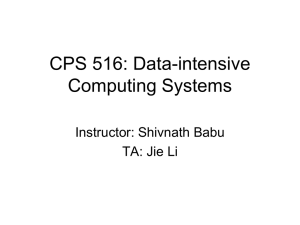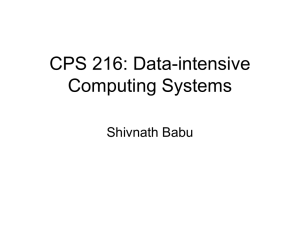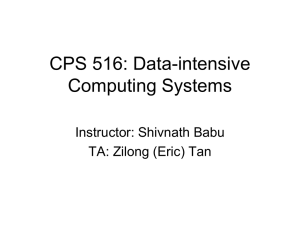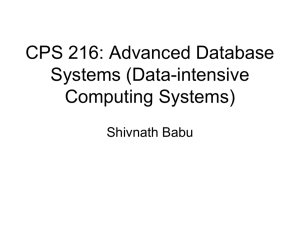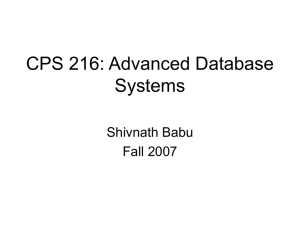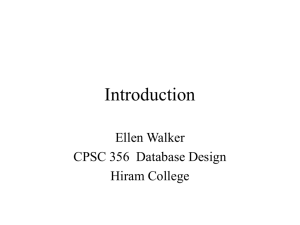CPS 216: Advanced Database Systems Shivnath Babu
advertisement
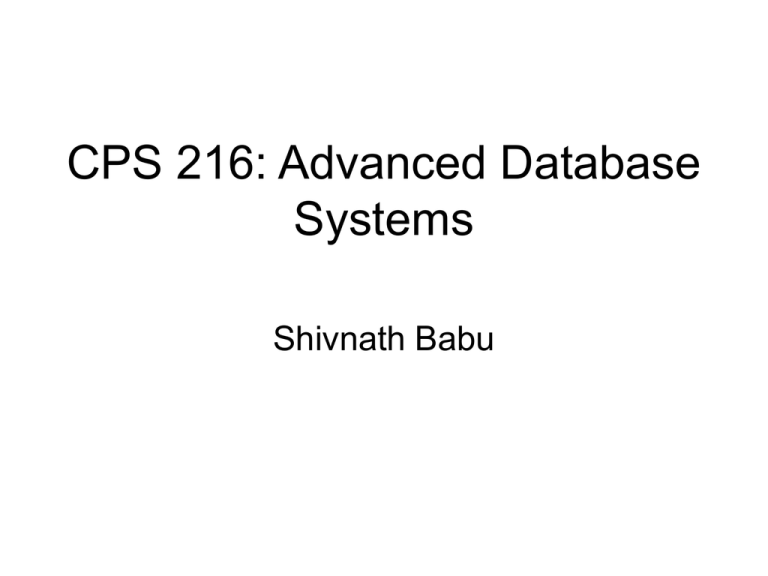
CPS 216: Advanced Database Systems Shivnath Babu Outline for Today • What this class is about: Data management • What we will cover in this class • Logistics What does a Database System mean to you? (Hint: What are they used for? Give examples) User/Application Data Management Query Query Query Data DataBase Management System (DBMS) Example: At a Company Query 1: Is there an employee named “Nemo”? Query 2: What is “Nemo’s” salary? Query 3: How many departments are there in the company? Query 4: What is the name of “Nemo’s” department? Query 5: How many employees are there in the “Accounts” department? Employee Department ID Name DeptID Salary … ID Name … 10 Nemo 12 120K … 12 IT … 20 Dory 156 79K … 34 Accounts … 40 Gill 89 76K … 89 HR … 52 Ray 34 85K … 156 Marketing … … … … … … … … … DataBase Management System (DBMS) High-level Query Q Answer DBMS Data Translates Q into best execution plan for current conditions, runs plan Example: Store that Sells Cars Make Model OwnerID ID Name Owners of Honda Accords Honda Accord 12 12 Nemo who are <= Honda Accord 156 156 Dory 23 years old Join (Cars.OwnerID = Owners.ID) Filter (Make = Honda and Model = Accord) Cars Age 22 21 Filter (Age <= 23) Owners Make Model OwnerID ID Name Age Honda Accord 12 12 Nemo 22 Toyota Camry 34 34 Ray 42 Mini Cooper 89 89 Gill 36 Honda Accord 156 156 Dory 21 … … … … … … DataBase Management System (DBMS) High-level Query Q Answer DBMS Keeps data safe and correct despite failures, concurrent updates, online processing, etc. Data Translates Q into best execution plan for current conditions, runs plan DBMS is multi-user • Example Get account balance from database; If balance > amount of withdrawal then balance = balance - amount of withdrawal; dispense cash; store new balance into database; • Homer at ATM1 withdraws $100 • Marge at ATM2 withdraws $50 • Initial balance = $400, final balance = ? – Should be $250 no matter who goes first Final balance = $250 Homer withdraws $100: read balance; $400 if balance > amount then balance = balance - amount; $300 write balance; $300 Marge withdraws $50: read balance; $300 if balance > amount then balance = balance - amount; $250 write balance; $250 Final balance = $300 Homer withdraws $100: Marge withdraws $50: read balance; $400 read balance; $400 If balance > amount then balance = balance - amount; $350 write balance; $350 if balance > amount then balance = balance - amount; $300 write balance; $300 Final balance = $350 Homer withdraws $100: Marge withdraws $50: read balance; $400 read balance; $400 if balance > amount then balance = balance - amount; $300 write balance; $300 if balance > amount then balance = balance - amount; $350 write balance; $350 Concurrency control in DBMS • Similar to concurrent programming problems – But data is not all in main-memory • Appears similar to file system concurrent access? – Approach taken by MySQL initially; now MySQL offers better alternatives • But want to control at much finer granularity • Or else one withdrawal would lock up all accounts! Recovery in DBMS • Example: balance transfer decrement the balance of account X by $100; increment the balance of account Y by $100; • Scenario 1: Power goes out after the first instruction • Scenario 2: DBMS buffers and updates data in memory (for efficiency); before they are written back to disk, power goes out • Log updates; undo/redo during recovery DataBase Management System (DBMS) High-level Query Q Answer DBMS Keeps data safe and correct despite failures, concurrent updates, online processing, etc. Data Translates Q into best execution plan for current conditions, runs plan Summary of modern DBMS features • Persistent storage of data • Logical data model; declarative queries and updates ! physical data independence • Multi-user concurrent access • Safety from system failures • Performance, performance, performance – Massive amounts of data (terabytes ~ petabytes) – High throughput (thousands ~ millions transactions per minute) – High availability (¸ 99.999% uptime) Modern DBMS Architecture Applications SQL DBMS Parser Logical query plan Query Optimizer Physical query plan Query Executor Access method API calls Storage Manager Storage system API calls File system API calls OS Disk(s) World of “Big Data” • Numbers reported by Google from 2007: – Data processed per month is 400 PB (PetaBytes) – Average job size is 180 GB • For 180 GB of data, it takes: – 30 minutes to read from disk (@100 MB/s) – 600 minutes to download at 5 MB/s • Big data is hard to move (but easy to store – few cents per GB) • Can throw parallelism at the problem Word Count over a Given Set of Web Pages see bob throw see spot run see bob throw see spot run 1 1 1 1 1 1 bob run see spot throw Can we do word count in parallel? 1 1 2 1 1 The MapReduce Framework (pioneered by Google) Automatic Parallel Execution in MapReduce Handles failures automatically, e.g., restarts tasks if a node fails; runs multiples copies of the same task to avoid a slow task slowing down the whole job Course Outline • Principles of query processing (25%) – Indexes – Query execution plans and operators – Query optimization • Data storage (15%) – Databases Vs. filesystems (Google FileSystem, Hadoop Distributed FileSystem) – Row-oriented Vs. column-oriented storage – Flash memory and Solid State Drives • Scalable data processing (30%) – Parallel query plans and operators – Systems based on MapReduce – Scalable key-value stores • Concurrency control and recovery (15%) – Consistency models for data (ACID, BASE, Serializability) – Write-ahead logging • Information retrieval and Data mining (15%) – Web search (Google PageRank, inverted indexes) – Association rules and clustering Course Logistics • Useful reference: Database Systems: The Complete Book, by H. Garcia-Molina, J. D. Ullman, and J. Widom • Web site: http://www.cs.duke.edu/courses/fall09/cps216 • Grading: – Project 40% – Homework Assignments 15% – Midterm 20% – Final 25% Summary: Data Management is Important • Core aspect of most sciences and engineering today • Core need in industry (esp., “big data”) • Cool mix of theory and systems • Chances are you will find something interesting even if you primary interest is elsewhere
